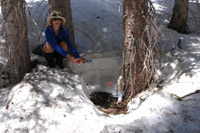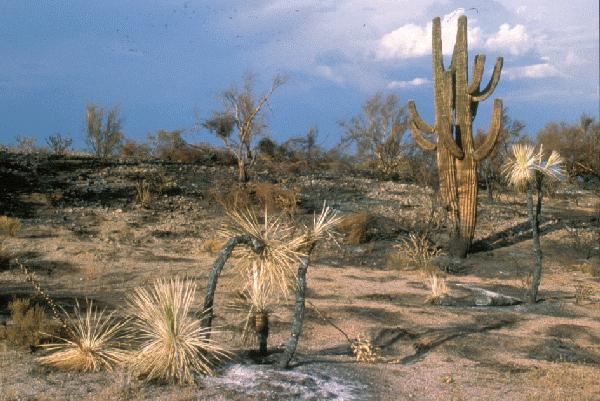- Home
- About S&T
- Taxa/Organisms
- Ecosystems
- Issues
- Methods & Tools
- Reports & Publications
- Location
- Search
Publisher: USGS | Science Center: Western Ecological Research Center (WERC, Sacramento) | Format: URL
www.werc.usgs.gov — This project started to conduct an extensive review of the literature pertaining to restoring degraded desert tortoise habitat, with emphasis on the Mojave Desert. Recovery to pre-disturbance plant cover and biomass may take from 50-300 years while complete ecosystem recovery may require over 3,000 years. Restoration can be used to enhance the More...

Publisher: USGS | Science Center: Fort Collins Science Center (FORT, Ft. Collins) | Format: URL
www.fort.usgs.gov — Encroaching development, overuse, and air- and waterborne contaminants from outside park boundaries are causing noticeable changes to water quality and ecosystem health and functioning. The Front Range metropolitan area from Fort Collins south to Colorado Springs includes 75 percent of Colorado's population and its most productive agricultural More...

Publisher: USGS | Science Center: Columbia Environmental Research Center (CERC, Columbia) | Format: URL
www.cerc.usgs.gov — The BFRS works cooperatively with team members from CERC and with faculty and graduate students of Department of Wildlife and Fisheries Sciences at Texas A&M University in research areas represented by the branch structure of the CERC including toxicology, ecology, biochemistry and physiology, environmental chemistry, ecogeography, and information More...

Publisher: USGS | Science Center: Western Ecological Research Center (WERC, Sacramento) | Format: URL
www.werc.usgs.gov — This issues overview and its resources deal with the spread of nonnative grasses in the Sonoran desert of Arizona has increased the risk of devastating fires by ignited fuel. The saguaro cactuses and desert tortoises have suffered catastrophic population losses as a result of these fires fueled by nonnative grasses. Read more about nonnative More...

Publisher: USGS (San Diego Field Station) | Science Center: Western Ecological Research Center (WERC, Sacramento) | Format: URL
www.werc.usgs.gov — The Pacific iguanas of the Fijian and Tongan archipelagos are a biogeographic enigma in that their closest relatives are found only in the New World, separated by 8,000 km of ocean. The Pacific iguanas have been dramatically affected by human activities; two species were eaten to extinction after human arrival in the Pacific some 2,800 years ago. More...

Publisher: USGS | Science Center: Fort Collins Science Center (FORT, Ft. Collins) | Format: URL
www.fort.usgs.gov — This resource has been developed to provide source materials on the history of the invasion, continuing threats, research results, and containment and management of the brown Treesnake (Boiga irregularis) in Guam and its relevance to other islands and mild continental environments. Users can report snake sightings on this website, get information More...

Publisher: USGS | Science Center: Forest and Rangeland Ecosystem Science Center (FRESC, Corvallis) | Format: URL
fresc.usgs.gov — Description of a project to determine the status of reptiles and amphibians at Olympic National Park. Includes project objectives, metadata, related publications, and contact information.

Publisher: USGS | Science Center: Forest and Rangeland Ecosystem Science Center (FRESC, Corvallis) | Format: URL
fresc.usgs.gov — There is a relatively rich herpetofauna in southwestern Oregon with about 38 species present. These species are almost equally divided between amphibians and reptiles. The objective of this issue overview is to conduct field surveys and assess status of several amphibian species of management concern, including: Western toad (Bufo boreas), Cascade More...

Publisher: USGS | Format: URL
pubs.usgs.gov — The steps necessary to conduct a pitfall trapping survey for small terrestrial vertebrates are presented. Descriptions of the materials needed and the methods to build trapping equipment from raw materials are discussed. Recommended data collection techniques are given along with suggested data fields. Animal specimen processing procedures, More...

Publisher: USGS | Science Center: Florida Integrated Science Center (FISC, Gainesville) | Format: URL
fl.biology.usgs.gov — This website links to descriptions, images, and vocalizations of Amphibians & Reptiles of the Southeastern United States and the U.S. Virgin Islands. Species profiles for Frogs and Toads, Salamanders, with a Glossary of Useful Herpetological Terms, as well as links to FISC's Herpetology Program, the Southeast ARMI initiative, Southeast ARMI Fact More...

Publisher: USGS | Science Center: Western Ecological Research Center (WERC, Sacramento) | Format: URL
www.werc.usgs.gov — This site is a field guide to the reptiles and amphibians of coastal Southern California, including species accounts, illustrations of tadpoles, and images of different habitat types. The guide also contains a glossary of terms, a map of the study area, and types of habitats.

Publisher: USGS | Science Center: Patuxent Wildlife Research Center (PWRC, Laurel) | Format: URL
www.pwrc.usgs.gov — The Biological Survey Unit, formerly the Bureau of Biological Survey, played a major role in the collection of North American Birds housed at National Museum of Natural History (NMNH). This website gives a historical perspective of the history and organization of the collections and research of not only mammals, amphibians and reptiles curated by More...
